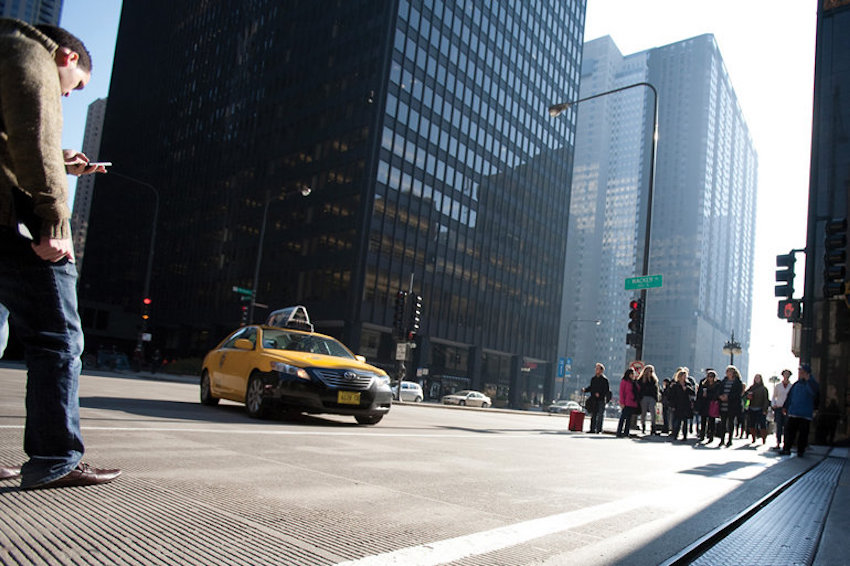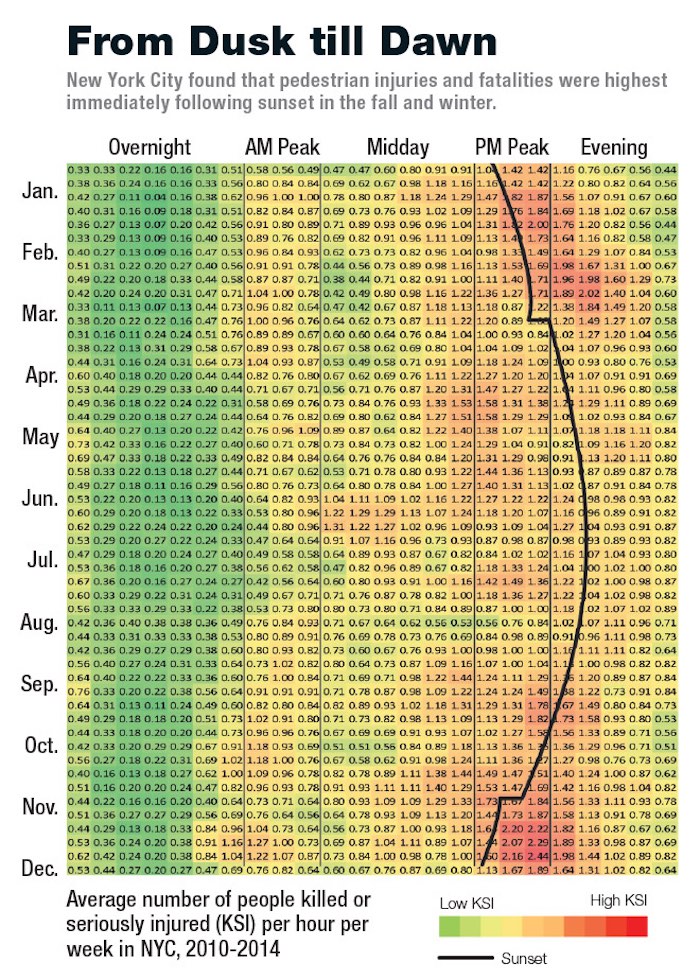As dozens of cities try to emulate Sweden’s success, they’re learning what works and what doesn’t.

Shirley Gonzales made no secret of her views on transportation when she ran for the San Antonio City Council in 2013. She laid them out in her answer to a questionnaire: “pedestrians first, followed by cycling, public transportation and private automobiles, in that order.” Gonzales promoted this agenda even though she was running in a city where fewer than 2 percent of commuters walk to work.
A few months later, after she’d won the election, the tales of some of her constituents drove the issue home. Most prominent was the story of Sharon Ledesma, a 28-year-old single mother who was crossing a four-lane street one night when a car switched lanes and veered toward her and her two children. Ledesma managed to push the children out of the way. Dominic, who was 11 at the time, and Mallory, who was 8, survived but had serious injuries. Both had broken bones and were on crutches for weeks. Ledesma, however, did not make it. She was declared brain dead at the hospital. The next day, after her kids had a chance to say goodbye, her family took her off life support.
Gonzales began to hear from other San Antonio families. The city had one of the highest pedestrian death rates in the country. In fact, 373 pedestrians had died in the metropolitan area over the previous decade. And Gonzales’ own district, largely poor and Hispanic, had some of the most dangerous streets, especially Culebra Road, the arterial where Ledesma died. That four-lane road shares many of the characteristics of other deadly stretches for pedestrians: Cars traveling near the speed limit of 40 mph pass between modest homes and retail outlets, while pedestrians walk along sidewalks separated from the traffic by only a low curb for as much as half a mile between crosswalks.
From our partners:
Gonzales’ constituents kept asking, “Isn’t there something you can do to slow down this street?” The new city councilwoman wanted to know too.
That’s how Gonzales came across the New York City program called Vision Zero. The premise is that no one needs to be killed while traveling, whether by car, bicycle, bus or foot. Saving lives, in other words, is more important than getting home faster. She pushed San Antonio to join the movement, and it did. Instead of the 54 pedestrians who died in the city in 2014, San Antonio would shoot for zero. The goal was the same for cyclists, drivers and automobile passengers.
Vision Zero has a long way to go before reaching its goal, and indeed an absolute elimination of traffic deaths is difficult even to imagine, but the movement has already had a positive impact in the three years since it came to the United States. Most important, in some cities, including New York, the number of traffic fatalities has dropped significantly under Vision Zero, even as national numbers are climbing. Vision Zero is now official policy in nearly two dozen U.S. cities, from Portland, Ore., to Fort Lauderdale, Fla. It is forcing transportation planners all over the country to rethink their priorities. Both the U.S. Department of Transportation and a national organization of state transportation officials have embraced similar concepts, one of which is called “Toward Zero Deaths.” But whether Vision Zero will be effective in the long run is still an open question. It will require cities to commit wholeheartedly to its audacious goal and to stick with it for years on end. That’s the key to Vision Zero — and also the hardest part to achieve.
Vision Zero began as an initiative of the Swedish government in 1997. The first big push under the program was to address vehicle deaths on rural roads. The government started building three-lane, rather than two-lane, roads for those areas, with the center lane used for passing. Later, Sweden began focusing on urban areas, building separated bike lanes, lowering speed limits and creating pedestrian-only zones. The years of effort paid off: Sweden now has one of the lowest traffic fatality rates in the world.
The concept made its debut in the United States in the weeks following the inauguration of New York City Mayor Bill de Blasio in 2014. Vision Zero was just one of several items on the mayor’s transportation agenda, but a spate of traffic deaths in the weeks before his swearing-in convinced him to make it a top priority.
De Blasio announced the program the week he took office, and gave his administration 30 days to come up with a plan for achieving it. Within a month, New York City had a list of 63 action items to improve traffic safety. “It was an extraordinary moment,” says Transportation Commissioner Polly Trottenberg. “It was the kind of bold, ambitious goal that understandably elected officials often don’t want to make, because it’s a goal that you know is going to be tough to reach.”
Developing New York’s plan wasn’t simply a matter of taking the Swedish model and importing it to the United States. The Swedish national government, after all, has far more sweeping powers than an American city does. It can regulate vehicle design, increase criminal penalties and change licensing requirements. New York City, on the other hand, had to ask permission from the state legislature just to lower its citywide speed limit from 30 mph to 25 and to install more speed cameras. The legislature agreed to both changes.
Given the complications, city officials had to look closer to home to find other ways to reduce traffic deaths. They started with the traditional cornerstones of traffic safety campaigns: education, enforcement and engineering. When New York won the right to lower its speed limit, it mounted a “25 to 25” public education campaign 25 days before the change went into effect, explaining to the public that a pedestrian hit by a car going 30 mph has a 20 percent chance of dying, while one hit by a car going 25 mph has only a 12 percent fatality rate. Once the message got out, the city stepped up its enforcement of speeding laws, using both police officers and speed cameras in school zones. Meanwhile, engineers made a commitment to reconfigure 50 dangerous streets and intersections a year, using narrower lanes and other improvements that encourage drivers to move more slowly.
That emphasis on street design is one of the hallmarks of Vision Zero. “We spend a lot of time, a lot of energy and money educating individuals about safe behaviors,” says Leah Shahum, the founder and director of the Vision Zero Network. “There is still a place for that.” But, she adds,
“how we design or redesign our streets has a huge impact on behavior.”
It’s no coincidence, in other words, that the most dangerous streets for pedestrians in cities are the arterials like Culebra Road in San Antonio. Fast-moving traffic, poor lighting, limited pedestrian crossings and unprotected sidewalks on roads that cut through neighborhoods are a fatal formula for those on foot. And while a more traditional safety campaign might try to stop those deaths by educating people about the dangers of jaywalking, Vision Zero seeks to address the reasons why pedestrians feel compelled to dart across dangerous roads to begin with.
For Vision Zero, crashes are not “accidents;” they are often the result of deliberate decisions to prioritize smooth traffic flow over safety. Proponents of the campaign anticipate that all users of the transportation network — drivers, cyclists and pedestrians — will make mistakes. But simple mistakes shouldn’t cost people their lives. “Vision Zero is not about eliminating all crashes. That’s not possible,” Shahum says. “The issue is: How can we lessen the severity of those crashes?”
Although pedestrian deaths often draw the most attention, Vision Zero employs the same strategies for other road users too. Corinne Kisner, policy director at the National Association of City Transportation Officials, has seen the benefits of improved street design. “When you redesign a street to improve safety for people walking and biking, it makes it safer for everybody,” she says. “A lot of the strategies that are part of the Vision Zero redesign, for example reducing turning conflicts [at intersections], actually reduce crashes for people driving as well.”

To draw up their Vision Zero plans, cities have relied on two major sources of information: data analysis and discussions among city agencies and outside community groups. Both have produced unexpected insights that have forced local officials to recalibrate their approaches.
New York City, for instance, studied fatal crashes that involve left-turning vehicles, because approximately one out of every eight pedestrian and cyclist deaths in the city between 2010 and 2014 involved such vehicles. “We’ve known for a while that left turns are three times as deadly as right turns, but we didn’t know why exactly until we did this deep study,” says Juan Martinez, the director of strategic initiatives for the city’s transportation department. “What we found is that it’s mostly highly correlated with the speed of the turn.”
To be sure, there are several factors that make left turns more dangerous: Drivers are under more stress, the frame of the car blocks their view and the “conflict zones” between cars and pedestrians are bigger, because many drivers cut the corners. But the biggest difference seems to be speed. Vehicles in fatal left-turn crashes are typically traveling about 9.3 mph, compared with 5.6 mph for right-turn crashes.
With a better understanding of the problem, New York is testing different ways to slow left-turn traffic at 100 intersections throughout the city. One approach has been to use paint and flexible posts to force drivers to travel farther into intersections before they start their turns. The city has also been restricting left turns in more places and using extra-long walk signals to give pedestrians a head start before vehicles enter an intersection.
Another breakthrough for New York City came last fall, when city officials analyzed the time of day and season of the year when pedestrians were killed. They noticed that pedestrian deaths shot up each year between September and January, and spiked right after sunset during the winter. The earlier the sunset, the more rush hour deaths occurred.

The city took out ads on drive-time radio to get the message to rush hour commuters to be extra careful in the evening in darker months. The transportation department installed new lighting at 1,000 intersections to better illuminate crosswalks. The police department moved officers from daytime to evening shifts, and mounted a campaign to crack down on drivers who failed to yield to pedestrians. In the first two months of the initiative, pedestrian deaths dropped to half of what they had been during that stretch the year before.
The numbers are looking better for overall traffic fatalities as well. There were 297 traffic deaths in New York City in 2013, before Vision Zero went into effect. That dropped to 257 in 2014 and a record low of 231 in 2015. The 2016 tally was lower still, at 225. “At the time we announced our dusk and darkness initiative,” Trottenberg says, “we were on track to have a significantly worse year [in 2016] compared to [2015] in terms of fatalities. We’ve really helped slow that trend. We’re naturally an agency that focuses on engineering because that’s our expertise, but it makes us realize we also need to focus more on the messaging side of things.”
Another lesson that data reinforced for New York is that the most dangerous roads were not necessarily the ones that drew the most complaints. Residents in poorer areas or immigrant communities often face the greatest hazards, but tend not to contact the city as much. So it’s necessary to look more closely at actual neighborhood statistics than at citizen feedback.
In Portland, Ore., the issue of neighborhood equity is even more front and center. Mayor Charlie Hales kicked off the city’s Vision Zero efforts at the headquarters of the Asian Pacific American Network of Oregon in the Jade District of East Portland, one of the most dangerous neighborhoods in the city for traffic deaths. Hales’ administration created a large task force that included black, Hispanic and Asian-American advocacy groups. As a result of those collaborations, city officials agreed to make sure that the Vision Zero program would not be used as justification for racial profiling by police. The cops would target behaviors, not communities. It’s one of the reasons why Portland plans to rely heavily on speed cameras for enforcement: Cameras don’t discriminate.
The community groups also pushed to make sure that crackdowns on dangerous driving came with chances for drivers to avoid fines or points on their licenses through diversion programs. They wanted the city to help immigrants with limited English understand the rules of the road. The transportation department also promised to prioritize road improvements that serve minority communities, elderly residents, children, people with disabilities and others who rely most heavily on walking, biking and transit to get around.
Leah Treat, director of the Portland Transportation Bureau, says those conversations are necessary for Vision Zero’s success, even though that means changes can take longer to roll out. Portland worked on its Vision Zero action plan for more than a year before it finally got city council approval. “You need to have a very broad group of people who will likely disagree with you and push you,” Treat says. “You have to reach compromise and reach consensus decisions, which is not easy. It takes a lot of time and a lot of communication.”
When it comes to the bottom line for Vision Zero — the number of traffic fatalities — the movement has had mixed results. While New York City’s improvements inspired many cities to join up, a lot of those cities are just now starting their programs. Meanwhile, traffic deaths nationally increased by 7.2 percent in 2015 and by 10.4 percent in the first half of 2016, a worrisome signal coming after a decades-long trend of overall decreases. Still, Vision Zero cities appeared to fare better than the country as a whole. “It’s exciting to hear cities talk about this, but we really need to learn about the implementation and the impact,” says Keshia Pollack, a professor at Johns Hopkins University and associate director of its Center for Injury Research and Policy. “It’s too soon to see a lot of impact, so people aren’t really evaluating it yet. But we know that implementation has varied tremendously. If a city says it’s going to adopt Vision Zero, what does that really mean? Those questions are not very clear.”
What is clear to Pollack, based on her research and safety campaigns she’s helped design in Baltimore and New York City, is that education campaigns won’t be enough on their own. Long-lasting changes depend on changes to the physical roads. “Engineering strategies are really important, because those are sustainable,” she says. “If you educate somebody today, they might move away and then you have to worry about the new people coming in tomorrow. With engineering strategies, such as putting in traffic calming or putting in lights with delays so that pedestrians can cross, those are really sustainable and important.”
In San Antonio, Councilwoman Gonzales is excited about several physical improvements that have been made to the city’s roadways. The city, for example, has installed a Z-shaped midblock crosswalk on Culebra Road. When pedestrians get to the road’s edge, they press a button to activate warning lights and then cross to a median. Once on the pedestrian island, they turn 90 degrees and walk to another button. The directional change forces them to look at oncoming traffic before making the second half of their crossing.
That said, Gonzales admits she is disappointed that the city’s Vision Zero plan focuses more on education than on engineering changes. She thinks the plan gives the city too much latitude to decide whether to make improvements. To kick off the city’s Vision Zero efforts in 2015, Gonzales joined Mayor Ivy Taylor at an event where 54 people stood on the steps of City Hall to represent each of the pedestrians killed in the city during 2014. That number dipped to 46 in 2015, but climbed back up to 65 in 2016.
Still, Gonzales is sticking by the program. “For so many years, mobility was the No. 1 concern for our roadways,” she says, “and safety was not even really even considered. So having that shift in culture, where we prioritize safety over mobility, is something that I’ve learned is going to take a long time to change.”

This feature originally appeared in Governing.


















